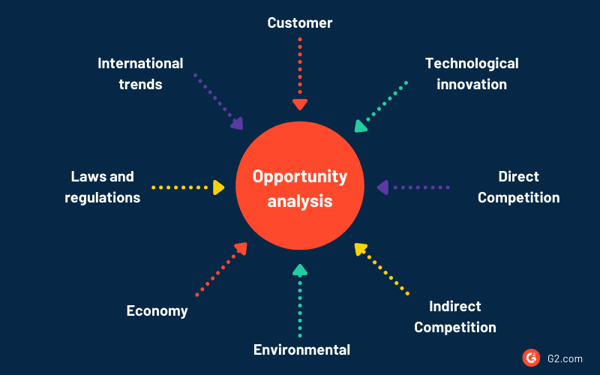January 27, 2021
 by Ninisha Pradhan / January 27, 2021
by Ninisha Pradhan / January 27, 2021

Opportunities are like free samples of food at the mall.
Sometimes, they taste great. Other times, they give you a bad feeling in the stomach, but you’ll never really know unless you take a bite.
In an ideal world, your business offering is absolute, growing on its own without being affected by external factors, and remains profitable for eons.
In reality, businesses are permeable to fluctuations in the market. How and when your business grows depends a lot on how quickly you identify different market opportunities that come your way.
The solution then must be to explore any and every possible opportunity in order to stay light years ahead of the competition, right?
Not exactly.
Just like in a restaurant menu, there could be a hundred different things to try out. That doesn’t mean your stomach will end up thanking you for taking on anything and everything, especially all at once. What might be “Today’s Special” could actually be something your business is allergic to.
To realize and leverage the right market opportunity for your business, you’ll need to conduct a market opportunity assessment. Let’s first break down what market opportunity means for your business and how you can make the most of it.
The future size of your business and revenue is estimated as market opportunity. Market opportunity analysis is a method that determines the desirability of a business opportunity. It forms a crucial portion of any business strategy where the market is analyzed to identify the anticipated revenues and profits from a product or service before launching it.
Remember the mall we talked about earlier? Imagine you have an ice cream counter, and you’re in charge of setting it up. How would you go about the entire process?
The first step would be to figure out the location of the counter. Would it be inside or outside of the mall? Next, what flavors would you be offering to everyone? Finally, what would you price your product?
These are the kind of questions you would ask when you embark on your market research. To answer these questions, you would need to tap into data that either you already have at hand or gather from various channels through market intelligence.
Now that you’ve set up your ice cream counter, you look for ways to grow your business. Maybe you could increase the price of each flavor? Perhaps you could create new deals or combos? Maybe you could partner with another popular brand to come out with a new flavor? These are just a few examples of market opportunities that could help your business explore new levels of growth.
It’s easy to get confused between market research and market opportunity considering that there are a lot of synergies between the two.
An easy way of understanding the difference is: market research gives you information on which market opportunities are worth your time.
.png?width=600&name=Market%20Research%20vs%20Opportunity%20analysis%20(2).png)
Markets can be a delicate thing, fluctuating as frequently as they do. Trying something different or ambitious for your business can feel risky.
But pursuing market opportunities shouldn’t have to be a high-stakes gamble. Market research done well can remove layers of ambiguity out of the equation.
When was the last time an opportunity sent out an invite for a scheduled visit?
That’s a trick question.
The occurrence of an opportunity cannot be planned – as much as we wish it could be. Ideally, you should be analyzing and evaluating market opportunities regularly.
But practically speaking, it’s cumbersome having to monitor every minute change in the market. It’s also not financially feasible to redirect a company’s focus area just to cater to every opportunity that looks promising.
One way to ease the market opportunity assessment process is by listing out your business goals. Understanding what the need of the hour is for your business helps you narrow down the kind of opportunities you should be looking for and what the best way of assessing these opportunities is.
Before you can assess your prospects, you’ll need to first identify market opportunities that are relevant to your business at its current stage.
The concept of an opportunity differs from organization to organization depending on how big they are, what industry they’re trying to get into, and what kind of growth they’re looking at.
Every business, at any level, has a threshold potential for growth. A successful market opportunity analysis can help realize this potential, as long as it’s customized to the needs and interests of the organization.
Here’s a quick guide on how an organization can identify new market opportunities at every level:
Startups are undoubtedly the most sensitive level on this list. As the “new kids on the block,” not only do they need to validate themselves as a service provider, they also need to be able to break even, let alone try to become profitable.
Cashing in on the right market opportunities can either help small businesses stay afloat or propel them to grow aggressively in their first decade.
Startups aren’t liquid enough to spend money on risky moves. Identifying the market potential at this level however, doesn’t require lavish capital lying around.
A few safe, yet surefire ways of identifying the right opportunities for startups are by:
The first thing startups need to ask themselves is what the addressable market size is for the market they’re trying to enter.
This would typically entail conversations about the total addressable market (TAM), serviceable available market (SAM), and the serviceable obtainable market (SOM).
But what if you’re trying to enter a market that doesn’t exist yet?
Most startups tend to be disruptors within an industry. How do you calculate the potential size of the market based off of the total market occupied by incumbents?
The short answer? You don’t.
It’s akin to Apple calculating the market size of iPhones in 2007 based on Nokia’s market share in cell phones around the same time. Case in point: Nokia had a market share of almost 50% back in 2007 – quite a change from its 3% market share in 2013.
A better approach to calculating potential market size is by redirecting the focus to the consumers. This is where segmentation comes into play.
Segregating the target consumer base on factors such as age, lifestyle, purchasing power, and a common pain point they face that could be solved by your business offering, is a great place to start.
This includes creating a mental map of each market segment and understanding social and psychological factors that influence potential customers' purchase decisions.
Segmenting the total addressable and serviceable market also helps startups understand how they should formulate their pricing models.
Being a new player, how you set your pricing sets the tone of the business for the next several years. Priced too high, and you run the risk of being unaffordable. Priced too low, and you might be mistaken for being low quality.
Understanding the psyche of your potential consumer base can tell you how much they’re willing to shell out for a quality product.
Analyzing the average purchasing patterns of the target market can provide more information than just how much you should be selling your product for. It can also tell you how the market chooses to make these purchases.
In Southeast Asian countries, e-wallets are the preferred mode of payment. In the Middle East, however, people are far more comfortable with the ‘Cash on Delivery’ option.
Again, these are just some generalizations that don’t necessarily dictate the purchasing behavior of what your target market may exhibit. Understanding what your target demographic prefers to work with just makes it that much easier for them to buy your product.
Another great piece of information that start-ups can glean insights from is when your target market looks for products or services that businesses like yours could offer. While businesses of all sizes make use of specific events and holidays with promotional offers, it can really make the difference for startups.
In a sense, startups can maximize their presence and introduce themselves to people who normally wouldn’t be listening to what they have to offer. Major events within a region or across the world push people to look for certain solutions and fast.
COVID-19 saw fintech companies providing free tools and software for core banking, wealth management, and lending in an effort to get legacy banks that hadn’t yet become fully automated, to take the plunge and test out the fintech waters for a limited time period.
This was a great way to get brick-and-mortar financial institutions acquainted with these firms’ software and possibly even convert a few into loyal customers.
Businesses in this level have tasted some success and moved past the nascent startup bubble. These businesses have an existing customer base and are probably looking at an expansion and possibly even new markets.
One of the biggest challenges that businesses have conquered at this level is validation. By now, these companies have quite a few logos and ‘number of customers’ emblazoned on their websites.
Unlike startups, emerging businesses have a bit more room to play with now that they have made some consistent revenue and have seen profitability in their existing business model.
This gives them the license to look at market opportunities that are slightly more ambitious and take a few calculated risks like:
Realizing success in your current business offering gives your organization confidence to explore adjacent market opportunities. This is a perfect time to explore the possibility of diversifying your product offerings and the company portfolio.
This could be in the form of launching a new product that is complementary to your existing product offering or moving into a substitute industry. In either case, the goal is to add a new product to your portfolio.
While the return on investment for both these options can be appealing, there are some pros and cons to both the options:
Another way of enhancing your business offerings is by forging strategic partnerships with businesses that can provide what you currently cannot. As much as we’d all like to be a one-stop shop for every feature possible, creating something from scratch is expensive and time-consuming.
This organization could be:
Rather than losing out on valuable time and to other competitors in the same space, it’s smarter to find another organization with a similar goal as yours, and build a symbiotic relationship with them.
Organizations at this level have seen peaks and valleys over the years. Businesses at this stage have reached a stage where things are stable and comfortable. Market opportunities at this stage would reside in a zone that sees meteoric growth and high risks in equal parts.
Although the risk-to-reward ratio in this level sits on the upper end of the spectrum, organizations at this stage have years of experience, customers, and revenue, to act as a cushion. The potential rewards are too tempting to ignore, and businesses at this level can realize market opportunities through several avenues.
What do large enterprises that have some serious cash to burn do?
They start acquiring smaller businesses that seem to be on the cusp of something big.
Mergers and acquisitions (M&A) have been treated as cautionary tales by some, urban legends by others. It’s hard to truly say whether or not an M&A is something to strategically look at or something you should stay away from.
It could best be described as a double-edged sword, considering over 70% of acquisitions have failed. The 30% that has worked, however, have been absolute gold mines.
While M&As can be unpredictable, it isn’t impossible to be able to project how beneficial such a move could be. A common theme observed with failed M&A attempts is that the acquirer is looking at the acquiree for the wrong reasons.
Most acquisition stories go like this:
It’s important to understand why you want to look at acquiring another business and what you have to offer to it apart from a cheque with several zeroes. If it’s about entering an emerging industry you haven’t stepped foot in yet, evaluate how long this industry is going to stay “hot”.
Additionally, ensure that your business can go the distance with this acquisition, and can take the other business to levels it can’t possibly imagine reaching at its current pace.
After all, everyone aspires to be the next Google-Android success story – not the next Tumblr and Yahoo! saga.
You’ve conquered your city, your state, and finally become a nationwide success. What comes next?
The best way for established businesses to grow their business further is by entering foreign markets. Unlike a new business, companies at this stage not only have a validated product, but they also have a good understanding of how the industry operates.
So how exactly should a business expand to another geography? Whip out the world map and pick a country that sounds appealing?
If only it were that simple to change zip codes.
One of the biggest mistakes companies make when trying to enter a new territory is assuming that you’ll knock it right out of the park, just because you’ve seen success in your current region.
In theory, most companies are aware that there is some amount of field research required before breaking new ground.
Here are some factors that organizations need to consider before entering a new region:
Moving to a foreign market is a little more nuanced than just translating your messaging to the local language in that region. People’s behavior and requirements vary drastically based on the business environment they are dealing with.
Most organizations set a goal to go global after years of business operations. Foreign markets can fill a textbook with all the examples of market opportunities that are out there. Here are two examples of organizations that have seen success and failure, on the other side of the pond:
Starbucks has been almost every expert’s favorite case study when it comes to demonstrating international expansion failures. Its attempt to conquer the Australian landscape had a not-so-happy ending and had to shut down around 70% of their stores.
But Gloria Jean’s, another American coffeehouse, thrived in Australia.
It was a case of Starbucks not understanding how to create relevance around their brand, not understanding how the Aussies liked their ambience, and not being able to provide a menu that was compatible with the population’s taste buds.
Another factor that plays a huge role in how people perceive products, is the culture in that region.
Ikea is known for its DIY approach to furniture, with ready-to-assemble pieces. People in India, however, are used to getting their furniture assembled for them. Not many Indians in the middle and upper classes own – let alone use – power tools, or read instruction manuals with intricate illustrations.
Nevertheless, Ikea has made strides in understanding what the demographic wants, making changes from the kind of wood that’s used in the furniture to the Indianized Swedish meatballs served on the menu.
It’s too soon to say whether or not Ikea will be able to win the subcontinent, but it certainly helps getting your field research right the first time around.
Expanding to a different geographic region is a great idea for a business, especially if the market it operates in is beginning to saturate. Unexplored markets can bring a host of new opportunities to the table, new customers, and a number of business lessons.
Now that you have identified a few opportunities relevant to your business, you need to evaluate which ones are worth your time and energy. While the analysis process may seem infinite, the market and the opportunities that come with it are broadly influenced by five factors:

Probably the most important factor on the list, customers and their behavior have the power to either create a market or end it. As dramatic as that sounds, the ultimate goal of any business is to obtain and sustain a customer.
If you have an established client list, go the extra mile and conduct personalized surveys with them. Pick their brains to understand what they like about your product. There’s no better source than existing customers to know what the market demand is.
An exercise like this helps you realize features or products you should be including as a part of your business and what features need to be cut out. It also helps marketers chalk out a marketing strategy that resonates well with your target audience.
If you don’t have existing customers, look at your competitors and their customers. What makes them gravitate towards your competitors? Are there gaps in their products or services that you could address with your business?
There are tons of databases and analytics available to help your business with its customer surveys. Depending on which demographic your customers fall under, identify the right source of information to pull data from.
Monitoring trends can open up a new realm of opportunities and the best way to stay on top of the trends is to understand who are the key drivers of an industry: the customers.
Technology has always been at the forefront of industrial advancement. Today, the market is seeing an abundance of disruptors that are here not not only shake things up, but drastically change the way an industry operates.
Whether you’re a startup or a leading enterprise, the biggest market opportunities lie in new technology that could give a product or an operation a serious upgrade.
The key to finding a lucrative market opportunity with respect to technology is to either invent something new or find a use case for an existing piece of technology that has never been explored before.
By studying other industries that are different to the one you currently operate in, you could adopt a process or technology that could be commercialized by your business. This is a great way of innovating your space without having to invent something from scratch.
Your competition is a reflection of your industry today.
While analyzing your direct competition is a no-brainer, it is equally important to keep tabs on who your indirect competitors are.
Indirect competition would offer products that are complementary to yours. It is only a matter of time before the competition starts nudging their way into the same business you are currently operating in. It is wise to closely monitor businesses that have the scope to enter multiple industries.
Take the example of a business that offers optical character recognition (OCR) software as a tool. This has the potential to enter any industry that has a use case for scanning text on documents or in any written form.
A thorough competitor analysis can help your business gain a competitive advantage by answering questions such as:
Most factors on this list can affect the industry gradually. A change in the laws or regulations, however, can affect the industry almost overnight. If your business operates in a high-impact industry, chances are your business is most likely to be affected by any change in policies.
While it’s important to be aware of the goings-on within the industry and what your policymakers are saying, quite often businesses end up learning about significant changes later rather than earlier.
A great way to prepare your business for any possible change is to read up about changes in laws and regulations in foreign countries.
For instance, the Monetary Authority of Singapore, in an effort to foster a digital ecosystem, has been steadily rolling out open banking licenses to non-banking players since 2019. This has spurred the rise of digital banking platforms, which are revolutionizing the way financial services are delivered. Incumbent banks have had every reason to worry and look at a digital banking approach more seriously than ever before.
Changes in the environment have influenced market opportunities over time, and indirectly affect each of the factors that have been listed above.
Climate change has made policymakers enforce new regulations, ultimately affecting the way businesses operate. Recession affects many small businesses in addition to industries as a whole, like real estate and luxury goods.
Companies can find new opportunities by going green, with renewable energy, and environmentally friendly packaging and clothing. The pandemic has opened up opportunities for the healthcare industry, with an increase in demand for sanitary products, vaccines and immunity supplements.
While identifying and assessing a market opportunity may require considerable time and research on your part, it isn’t something you pick up and drop after a month or even a quarter. Market opportunities require commitment and need to be seen through till its conclusion before you start pursuing another opportunity.
Tired of battling competitors for market share? Designing a new category is a great market opportunity worth exploring for your business!
Ninisha is a former Content Marketing Specialist at G2. She graduated from R.V College of Engineering, Bangalore, and holds a Bachelor's degree in Engineering. Before G2, Ninisha worked at a FinTech company as an Associate Marketing Manager, where she led Content and Social Media Marketing, and Analyst Relations. When she's not reading up on Marketing, she's busy creating music, videos, and a bunch of sweet treats.
Data labeling teaches machines how to understand different pieces of information. It is the...
 by Sagar Joshi
by Sagar Joshi
Last fall, I was privileged to join G2’s Executive Advisory Board (EAB) for an offsite...
 by Godard Abel
by Godard Abel
Content marketers around the world gathered in San Diego this April for the inaugural Content...
 by Devin Pickell
by Devin Pickell
Data labeling teaches machines how to understand different pieces of information. It is the...
 by Sagar Joshi
by Sagar Joshi
Last fall, I was privileged to join G2’s Executive Advisory Board (EAB) for an offsite...
 by Godard Abel
by Godard Abel


